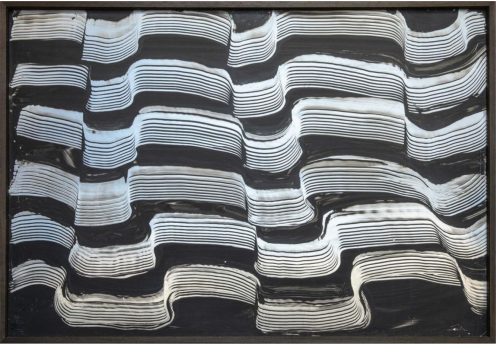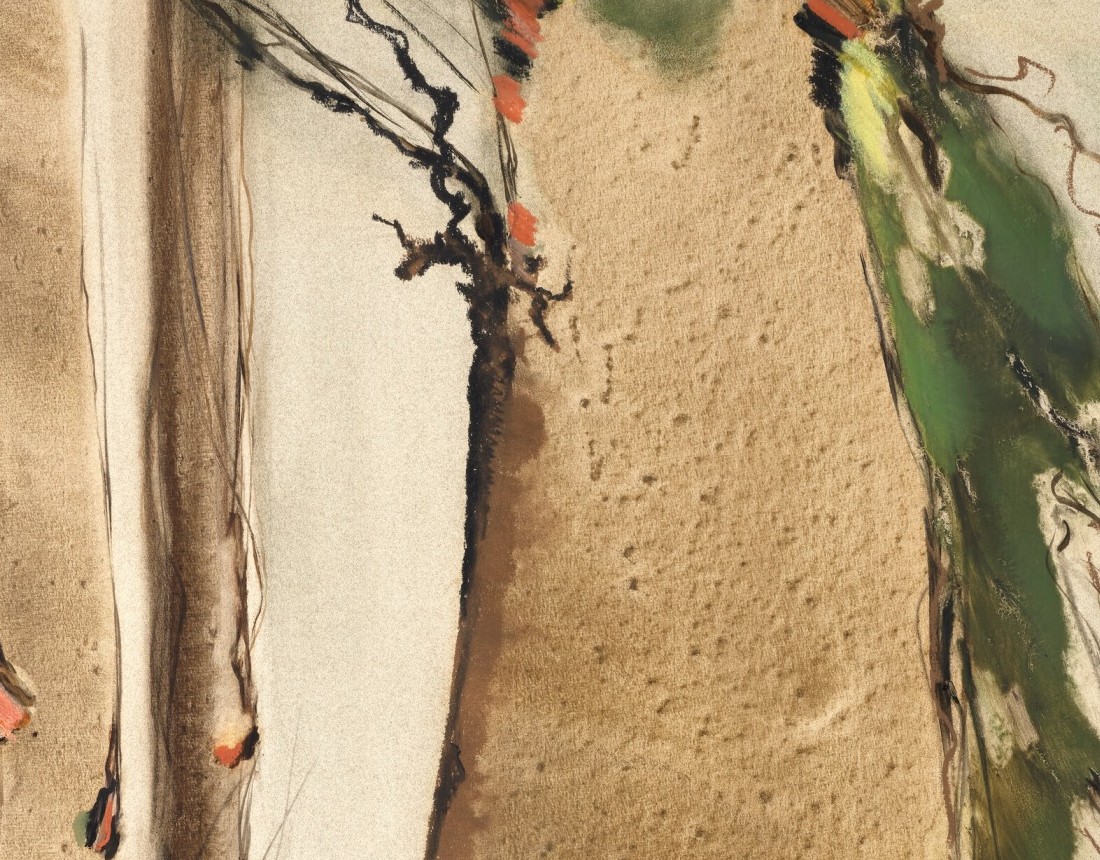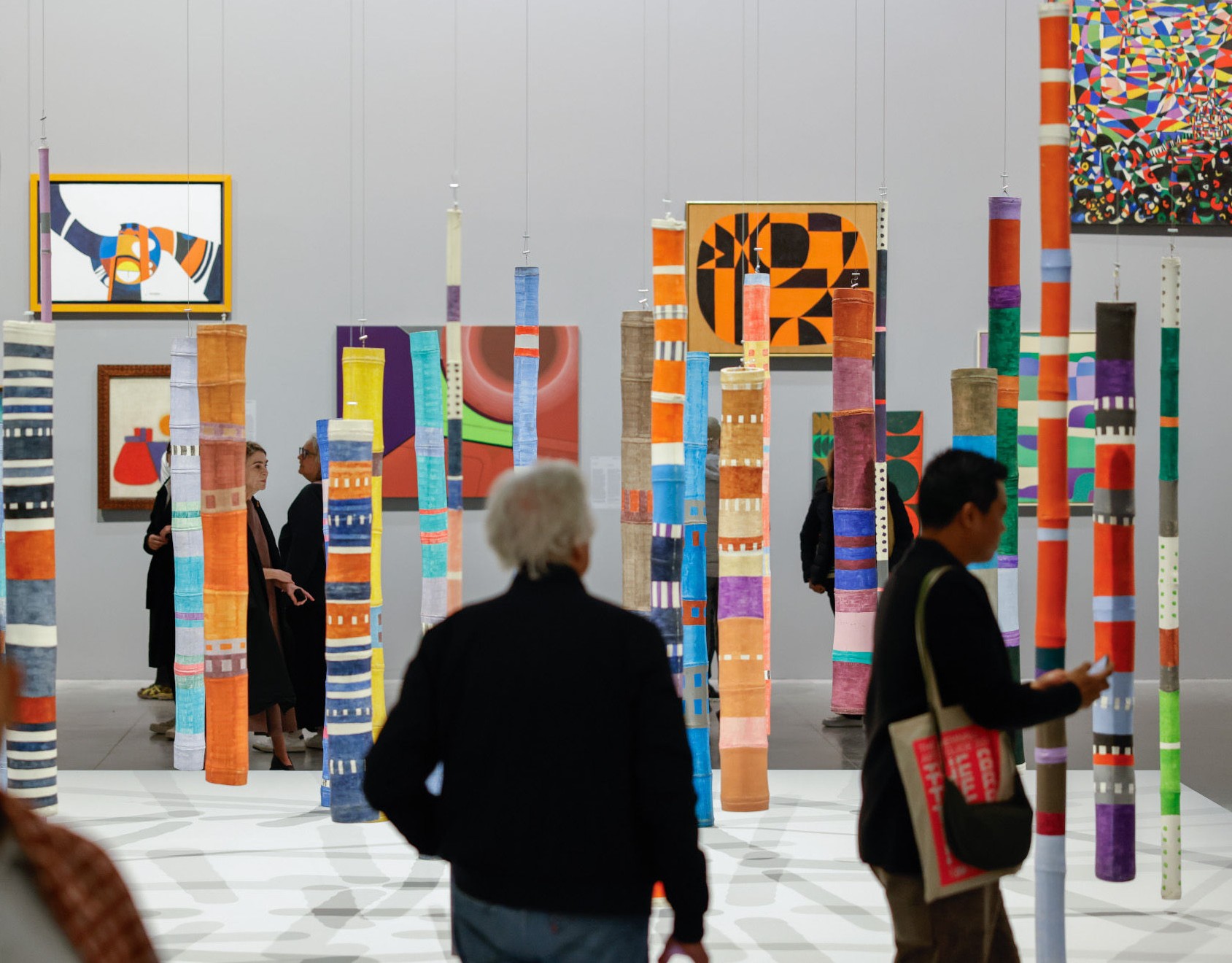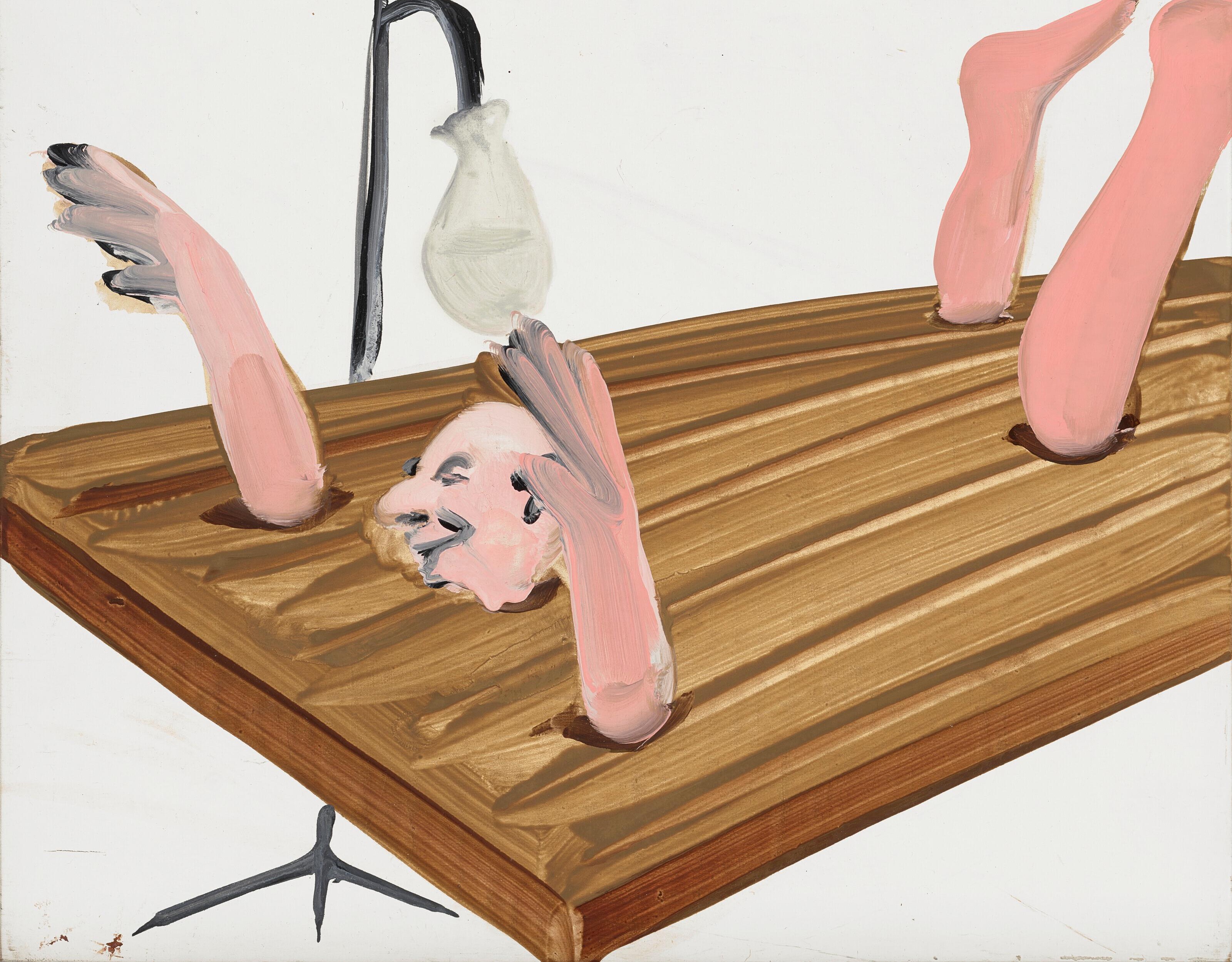About Behjat Sadr
Behjat Sadr is one of the pioneers of abstract painting in Iran.
In 1948, she entered the Faculty of Fine Arts in University of Tehran, and in 1954, she graduated from this faculty with the first rank. In 1956, she went to Italy with a scholarship in art. He studied at the Roberto Milli Academy and then the Naples Academy of Fine Arts. She participated in the Venice Biennale the following year. She held her first solo exhibition in 1957 at the Pinco Gallery in Rome. During her education in Italy, she participated in several group exhibitions.
She returned to Iran in 1959 and from the following year began teaching at the Faculty of Fine Arts in Tehran, and also took over the management of the faculty's visual department in a short period of time. She participated in the third Tehran Biennial and won the first prize. She also received the UNESCO Prize in the "Competition against Illiteracy" art competition in 1967. In 1980, she went to France and due to an illness, she remained there for treatment. In 2004, the Tehran Museum of Contemporary Art exhibited her works from various periods of her career in the title of "Pioneers of Modern Iranian Art". Sadr died in France.
For about five decades, her paintings included a highlighted collection of cold and matte oil paints, on different backgrounds with the combination of different materials such as wood and aluminum, and photo-painting collages. She pursued her path of artistic experiences by "action painting" style inspired from the "R Informal '' style in Europe, in emotional behaviors with canvas and color.
She created artworks with harmonious compositions and flexible lines, using the spatula painting technique and the canvas on the ground. The widespread variety of Sadr's artworks shows her seeking spirit, regardless of usual formats. Her research and struggle for various expressions has led her to the creation of various art works.
“Behjat Sadr's painting method is based on spraying and collecting paint, so that most of the work is formed in the stage of removing paint, not in the stage of pouring,” Alireza Sami-Azar writes about her. "For this purpose, first she poured the paint directly on the canvas or aluminum sheet and then spread it with a spatula or similar device on the surface of the painting so that the desired abstract shape gradually appeared. The movement of the hand in this process is naturally fast and very skillful, so that before the paint dries, it shows the shapes and textures on the surface of the painting in the artist's interpretation, in a negative way. The gentle and skillful use of the spatula allowed her to create wide lines and wavy surfaces, thus creating an abstract lyrical painting which is completely modern, based on repetitive ranges.”
In 1948, she entered the Faculty of Fine Arts in University of Tehran, and in 1954, she graduated from this faculty with the first rank. In 1956, she went to Italy with a scholarship in art. He studied at the Roberto Milli Academy and then the Naples Academy of Fine Arts. She participated in the Venice Biennale the following year. She held her first solo exhibition in 1957 at the Pinco Gallery in Rome. During her education in Italy, she participated in several group exhibitions.
She returned to Iran in 1959 and from the following year began teaching at the Faculty of Fine Arts in Tehran, and also took over the management of the faculty's visual department in a short period of time. She participated in the third Tehran Biennial and won the first prize. She also received the UNESCO Prize in the "Competition against Illiteracy" art competition in 1967. In 1980, she went to France and due to an illness, she remained there for treatment. In 2004, the Tehran Museum of Contemporary Art exhibited her works from various periods of her career in the title of "Pioneers of Modern Iranian Art". Sadr died in France.
For about five decades, her paintings included a highlighted collection of cold and matte oil paints, on different backgrounds with the combination of different materials such as wood and aluminum, and photo-painting collages. She pursued her path of artistic experiences by "action painting" style inspired from the "R Informal '' style in Europe, in emotional behaviors with canvas and color.
She created artworks with harmonious compositions and flexible lines, using the spatula painting technique and the canvas on the ground. The widespread variety of Sadr's artworks shows her seeking spirit, regardless of usual formats. Her research and struggle for various expressions has led her to the creation of various art works.
“Behjat Sadr's painting method is based on spraying and collecting paint, so that most of the work is formed in the stage of removing paint, not in the stage of pouring,” Alireza Sami-Azar writes about her. "For this purpose, first she poured the paint directly on the canvas or aluminum sheet and then spread it with a spatula or similar device on the surface of the painting so that the desired abstract shape gradually appeared. The movement of the hand in this process is naturally fast and very skillful, so that before the paint dries, it shows the shapes and textures on the surface of the painting in the artist's interpretation, in a negative way. The gentle and skillful use of the spatula allowed her to create wide lines and wavy surfaces, thus creating an abstract lyrical painting which is completely modern, based on repetitive ranges.”
The Most Expensive Artwork
At Auctions
First Attendance
23 October 2008
# Attendance
58
# Artworks
88
Average Realized Price
37,082 USD
Average Min Estimate
24,320 USD
Average Max Estimate
33,980 USD
Sell-through Rate
85.542%
Average Growth of Artwork Worth
43.159%
Timeline
Modern & Contemporary Middle Eastern Art auction
25 November
Modern & Contemporary Middle East auction
28 October
Modern + Contemporary Fine Art auction
20 February
The 22nd Tehran - Modern, Classic and Traditional Iranian Art auction
14 February
Modern and Contemporary Collector exhibition
7 February
Modern And Contemporary Art of The Middle East auction
30 January
A Tree-Rich Garden exhibition
15 November
Modern and Contemporary Middle Eastern Art auction
13 November
Abstract Illusions exhibition
11 October
Endless Treasures exhibition
21 June
Golden Years exhibition
14 June
Modern and Contemporary Art Dubai auction
31 May
A Collection exhibition
10 May
Connoisseur's Look exhibition
19 April
10s of Artworks, 10s of Millions exhibition
8 March
Modern and Contemporary Art From the Middle East and Asia auction
22 February
Beirut-Paris Part II - Middle Eastern Art Online Sale auction
24 July
Modern and Contemporary Middle Eastern Art auction
16 May
Ordibehesht exhibition
12 May
Footprint exhibition
1 May
Testimony of a Journey: The Al Zayani Collection auction
25 April
Realism exhibition
13 April
Middle Eastern Modern and Contemporary Part I auction
19 December
Behjat Sadr and Isabelle Cornaro's Artworks exhibition
24 November
20th Century Art / Middle East auction
23 March
A Selection of Modern Works from The Laal Collection exhibition
25 February
The 15th Tehran- Modern Iranian Art auction
14 January
10th Collector exhibition
7 January
MIDDLE-EAST MODERN & CONTEMPORARY auction
16 December
The Mana Jalalian Collection: A Rare Collection of Iranian Modern Art exhibition
15 November
Small Artworks collection exhibition
11 June
Painting, group exhibition exhibition
24 April
20th Century Art / Middle East auction
23 March
The 13th Tehran- Modern and Contemporary Iranian Art auction
15 January
20th Century Art / Middle East auction
20 October
INTERIORS AND CHARACTERS THE CITY APARTMENT auction
17 September
20th Century Art / Middle East auction
22 October
یازدهمین دوره حراج تهران auction
5 July
Modern and Contemporary Middle Eastern Art auction
1 May
20th Century Art / Middle East auction
30 April
(1924-2009) Behjat Sadr exhibition
5 April
20th Century Art / Middle East auction
23 October
Dusted Waters exhibition
28 September
The 9th Tehran- Classic and Modern Iranian Art auction
29 June
20th Century Art / Middle East auction
24 April
Kunst Und Antiquitäten auction
12 December
MODERN AND CONTEMPORARY ART FROM THE MIDDLE EAST auction
6 December
Boundless: Dubai auction
13 November
20th Century Art / Middle East auction
23 October
هفتمین دوره حراج تهران auction
7 July
Drouot Richelieu, Salle 5, Art Abstrait et Contemporain auction
9 June
Modern and Contemporary Middle Eastern Art auction
26 April
20th Century Art/ Middle East auction
25 April
Modern & Contemporary Art auction
18 March
20th Century Art: Middle East auction
20 October
ABSTRACT & CONTEMPORARY ART auction
15 June
پنجمین دوره حراج تهران auction
27 May
The Art of Lebanon and Modern and Contemporary Middle Eastern Art auction
27 April
20th Century Art / Middle East auction
20 April
Modern & Contemporary Art auction
16 March
Trace through the Black exhibition
22 January
Trace through the Black exhibition
22 January
20th Century Art - A Different Perspective auction
2 December
Iran Heartbeat exhibition
26 November
Modern & Contemporary Art auction
20 October
Drouot Richelieu, Salle 1, Tableaux Abstraits & Contemporains auction
12 June
چهارمین دوره حراج تهران auction
29 May
Modern & Contemporary Arab, Iranian and Turkish Art auction
18 March
ABSTRACT & CONTEMPORARY ART - FOREIGN PAINTERS OF THE PARISIAN SCENE auction
10 December
MODERN AND CONTEMPORARY PAINTINGS - PRESTIGE SALE auction
11 June
سومین دوره حراج تهران auction
30 May
دومین دوره حراج تهران auction
28 May
1Ere Vente a Dubai International Modern And Contemporary Art auction
22 October
- - February 2012 auction
2 February
Art Abstrait et Contemporain auction
5 July
- - May 2010 auction
10 May
Modern & Contemporary Arab, Iranian, Indian & Pakistani Art auction
24 November
International Modern and Contemporary Art auction
30 October
Modern and Contemporary Arab and Iranian Art auction
23 October
Articles
A Review of Christie's Modern and Contemporary Dubai Online Auction, Spring 2024 2 June 2024
The Modern and Contemporary Dubai online auction was held on Christie's website from May 9 to May 31, 2024. In this auction, works by 70 artists were featured, totaling 90 artworks. Out of these, 75 pieces were sold, resulting in a total sale of $2.2 million. Fourteen Iranian artists also had their works presented in this auction, achieving a 100% sales rate. The most expensive piec...
The Venice Biennale: A Creative Economy-Based Art Enterprise 14 May 2024
The Venice Biennale is one of the oldest and most prestigious avant-garde art exhibitions in the world, with a high level of credibility. In addition to presenting artists' works and introducing them, this biennial is important for predicting and creating new artistic trends. It manages its events with a multidisciplinary model of organization and management, which has made its natu...
A Look at the Market of Works of Iranian Female Artists 16 March 2024
In its annual publications, Artchart consistently evaluates the contributions of both male and female artists. Notably, in the report from the 19th Tehran auction, there is a focused analysis on the achievements of female artists throughout all Tehran auctions. The document presented below has been meticulously prepared to offer an in-depth investigation into the market presence of...
MODERN & CONTEMPORARY MIDDLE EASTERN ART: A REPORT 23 May 2023
In this report, the works of Iranian artists in the online auction of Christie's Dubai in the contemporary and modern art of the Middle East are discussed. In this auction, 15 works by Iranian artists were present, from veterans such as Manouchehr Yektai to young contemporary artists such as Rokni Haerizadeh. Information such as total sales, growth rate and the most expensive works...
Iran's Art in London's Islamic Art Week, An Overview 6 May 2023
London Islamic Art Week is an event that is held two to three times a year; Every spring and autumn, Sotheby's, Christie's, Bonham's, Chiswick and Rosebery's Islamic artauctions are held in different cathegories by the Islamic and Indian Art departments. These auctions include art works of the Islamic world from the middle of the 7th to the 20th centuries, and among them are works f...





